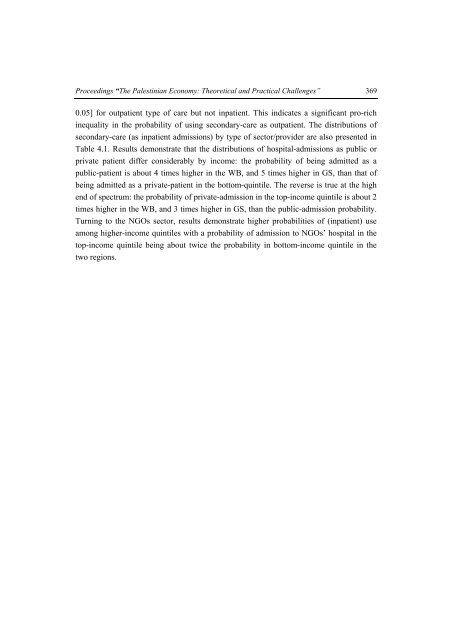The Palestinian Economy. Theoretical and Practical Challenges
The Palestinian Economy. Theoretical and Practical Challenges
The Palestinian Economy. Theoretical and Practical Challenges
You also want an ePaper? Increase the reach of your titles
YUMPU automatically turns print PDFs into web optimized ePapers that Google loves.
Proceedings “<strong>The</strong> <strong>Palestinian</strong> <strong>Economy</strong>: <strong>The</strong>oretical <strong>and</strong> <strong>Practical</strong> <strong>Challenges</strong>” 369<br />
0.05] for outpatient type of care but not inpatient. This indicates a significant pro-rich<br />
inequality in the probability of using secondary-care as outpatient. <strong>The</strong> distributions of<br />
secondary-care (as inpatient admissions) by type of sector/provider are also presented in<br />
Table 4.1. Results demonstrate that the distributions of hospital-admissions as public or<br />
private patient differ considerably by income: the probability of being admitted as a<br />
public-patient is about 4 times higher in the WB, <strong>and</strong> 5 times higher in GS, than that of<br />
being admitted as a private-patient in the bottom-quintile. <strong>The</strong> reverse is true at the high<br />
end of spectrum: the probability of private-admission in the top-income quintile is about 2<br />
times higher in the WB, <strong>and</strong> 3 times higher in GS, than the public-admission probability.<br />
Turning to the NGOs sector, results demonstrate higher probabilities of (inpatient) use<br />
among higher-income quintiles with a probability of admission to NGOs’ hospital in the<br />
top-income quintile being about twice the probability in bottom-income quintile in the<br />
two regions.
















